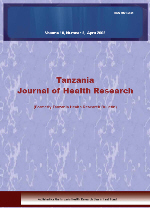
|
Tanzania Journal of Health Research
Health User's Trust Fund (HRUTF)
ISSN: 1821-6404
Vol. 16, No. 1, 2014, pp. 1-10
|
 Bioline Code: th14008
Bioline Code: th14008
Full paper language: English
Document type: Research Article
Document available free of charge
|
|
|
Tanzania Journal of Health Research, Vol. 16, No. 1, 2014, pp. 1-10
| en |
Postoperative pain management outcomes among adults treated at a tertiary hospital in Moshi, Tanzania
MASIGATI, HERBERT G. & CHILONGA, KONDO S.
Abstract
Inadequately controlled postoperative pain (POP) subjects individuals to complications which may be
fatal or leading to prolonged hospital stay. Complications from inadequately controlled POP may alleviate the
existing shortage of hospital human resource for health in health facilities in developing countries. The burden
and challenges of POP management at health facilities in Tanzania is not known. This study was therefore carried
out to evaluate postoperative pain management and patient satisfaction with care given at Kilimanjaro Christian
Medical Centre (KCMC). This descriptive prospective hospital based study, was conducted at the Kilimanjaro
Christian Medical Centre in Moshi, Tanzania from August 2011 to March 2012. POP and patients' satisfaction with
pain relief scores were assessed using pain and satisfaction numerical rating scales. Pain assessment was done at
24 hours and 48 hours after operation. Satisfaction was assessed on 48 hours post surgery. All adult patient
aged 18 years and above whom were operated in general surgery ward, KCMC and accepted by signing consent
were involved in the study. Patients suffering from nervous system were excluded from the study. A total
number of 124 patients were recruited and participated in the study. Sixty-five (52.4%) were males and 59 (47.6%)
females. Mean age (SD) years 40.9 ± 15.4. The largest percentage of individuals had mild pain both at rest
(45.2%) and during movement (44.4%). Patients whose analgesia was administered intravenously were more likely
to be satisfied with POP management than those given intramuscular analgesics (P= 0.028). Analgesia used in
combination increased significantly the proportion of pain free individuals 48 hours postoperative compared to
24 hours postoperative (P= 0.003). In conclusion, the postoperative pain management is still a challenge in our
centre as nearly half of the patient had mild pain in the first 48 hours post surgery.
Keywords
Postoperative pain; adults; satisfaction with treatment; Tanzania
|
| |
© Copyright 2013 - Tanzania Journal of Health Research
|
|
